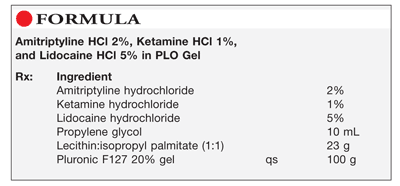US Pharm. 2014;39(3):62-63.

Method of Preparation: Calculate the quantity of each ingredient for the amount to be prepared. Accurately weigh or measure each ingredient. Mix the powders with the propylene glycol to form a smooth paste. Add this paste to the lecithin:isopropyl palmitate mixture and mix until uniform. Add sufficient poloxamer 20% gel to final weight and mix using a strong shearing action. Package and label.
Use: This preparation has been used in the treatment of neuropathic pain.
Packaging: Package in tight, light-resistant containers.
Labeling: For external use only. Keep out of reach of children. Discard after ____ [time period].
Stability: A beyond-use date of up to 30 days may be used for this preparation.1
Quality Control: Quality-control assessment can include theoretical weight compared with actual weight, specific gravity, active drug assay, color, texture–surface, texture–spatula spread, appearance, feel, rheologic properties, and physical observations.2
Discussion: This preparation, also called AKL, has been shown to significantly reduce burning levels on a long-term basis in patients experiencing neuropathic pain from radiation dermatitis.3
Amitriptyline hydrochloride (Elavil, C20H23N.HCl, MW 313.86) is a dibenzocycloheptene-derivative tricyclic antidepressant that shares the pharmacologic actions, uses, and potential toxicity of the tricyclic antidepressants. It occurs as white or practically white, odorless or practically odorless, crystalline powder or small crystals. It is freely soluble in water, alcohol, chloroform, and methanol.1,4,5
Ketamine hydrochloride (C13H16ClNO.HCl, MW 274.2) is used as an anesthetic and analgesic. It occurs as a white crystalline powder with a slight characteristic odor. Approximately 1.15 mg is equivalent to 1 mg of ketamine base. It is soluble 1 g in 4 mL of water, 14 mL of alcohol, and 60 mL of absolute alcohol.1,6
Lidocaine hydrochloride (C14H22N2O.HCl.H2O, MW 288.81) occurs as a white, odorless, crystalline powder with a slightly bitter taste. It is an amide-type local anesthetic with a rapid onset and intermediate duration of action. Lidocaine hydrochloride is very soluble in water (1:0.7) and in alcohol (1:1.5). It is available in both anhydrous and monohydrate forms. Approximately 1.16 g of lidocaine hydrochloride is equivalent to 1 g of lidocaine.1,7
Propylene glycol (C3H8O2) occurs as a clear, colorless, viscous, practically odorless liquid with a sweet taste, somewhat resembling glycerin. It has a specific gravity of 1.038 g/mL and is miscible with acetone, chloroform, 95% ethanol, glycerin, and water. Propylene glycol is not miscible with fixed oils or light mineral oil.8
Lecithin (egg lecithin, soybean lecithin, vegetable lecithin) is practically insoluble in water, polar solvents, and cold vegetable and animal oils; when mixed with water, however, it hydrates to form emulsions. Lecithin is soluble in aliphatic and aromatic hydrocarbons, mineral oil, and fatty acids.9
Isopropyl palmitate (C19H38O2, MW 298.51) is a colorless, mobile liquid with a very slight odor that is used as an emollient, oleaginous vehicle, and solvent. It is soluble in acetone, castor oil, cottonseed oil, alcohol, and mineral oil, and insoluble in water, glycerin, and propylene glycol. Isopropyl palmitate should be stored in well-closed containers and protected from light.10
Pluronic F127 occurs as a white-colored, waxy, free-flowing powder that is practically odorless and tasteless. It melts at about 56°C and is freely soluble in water, alcohol, and isopropyl alcohol.11
REFERENCES
1. U.S. Pharmacopeia 36/National Formulary 31. Rockville, MD: U.S. Pharmacopeial Convention, Inc; 2013:335-398,1242,1267-1268.
2. Allen LV Jr. Standard operating procedure for performing physical quality assessment of ointments/creams/gels. IJPC. 1998;2:308-309.
3. Uzaraga I, Gerbis B, Holwerda E, et al. Topical amitriptyline,
ketamine, and lidocaine in neuropathic pain caused by radiation skin
reaction: a pilot study. Support Care Cancer. 2012;20:1515-1524.
4. McEvoy GK, ed. AHFS Drug Information 2010. Bethesda, MD: American Society of Health-System Pharmacists; 2010:2413-2415.
5. Sweetman SC, ed. Martindale: The Complete Drug Reference. 36th ed. London, England: Pharmaceutical Press; 2009:376-382.
6. Sweetman SC, ed. Martindale: The Complete Drug Reference. 33rd ed. London, England: Pharmaceutical Press; 2002:1262-1263.
7. White HS. Local anesthetics. In: Gennaro AR, ed. Remington: The Science and Practice of Pharmacy. 20th ed. Baltimore, MD: Lippincott Williams & Wilkins; 2000:1402-1403.
8. Weller PJ. Propylene glycol. In: Rowe RC, Sheskey PJ, Quinn ME, eds. Handbook of Pharmaceutical Excipients. 6th ed. Washington, DC: American Pharmaceutical Association; 2009:592-594.
9. Sheng JJ. Lecithin. In: Rowe RC, Sheskey PJ, Quinn ME, eds. Handbook of Pharmaceutical Excipients. 6th ed. Washington, DC: American Pharmaceutical Association; 2009:385-387.
10. Taylor AK. Isopropyl palmitate. In: Rowe RC, Sheskey PJ, Quinn ME, eds. Handbook of Pharmaceutical Excipients. 6th ed. Washington, DC: American Pharmaceutical Association; 2009:350-351.
11. Collett JH. Poloxamer. In: Rowe RC, Sheskey PJ, Quinn ME, eds. Handbook of Pharmaceutical Excipients. 6th ed. Washington, DC: American Pharmaceutical Association; 2009:506-509.
To comment on this article, contact rdavidson@uspharmacist.com.





